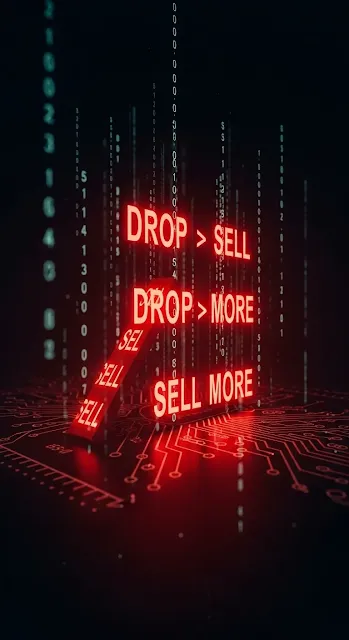At 2:42 p.m. on May 6, 2010, something unbelievable happened.
Nearly $1 trillion vanished from the stock market in just 5 minutes.
No bombs. No hackers.
Just… code.
What really happened that day?
A Sudden Freefall
A trader’s hand urgently reaching for the “CIRCUIT EMERGENCY” button — symbolizing the moment of panic.
On what seemed like a normal trading day, the Dow Jones suddenly plunged 998.5 points.
This massive drop wiped out close to $1 trillion in market value—only to recover within minutes.
This wasn’t a glitch.
It was a systemic chain reaction.
The Algorithm That Didn’t Wait
A wall clock showing 2:42 p.m., overlaid with crashing red stock charts — the exact moment the crash began.
The root cause?
A Kansas-based mutual fund placed a massive sell order: 75,000 E-mini S&P 500 futures contracts.
The algorithm was simple:
Sell as quickly as possible, no matter the price, no matter the volume.
High-Frequency Trading (HFT) bots noticed.
They didn’t panic.
They accelerated the trend.
Drop. Sell. Drop again. Sell more.
Machines That Sell Faster Than Thought
A cold, empty trading floor filled with automated monitors — one reading “AUTO EXECUTION IN PROGRESS.”
Once the bots mirrored the initial trade, it created a loop:
Every drop triggered more selling.
Every sale triggered more drops.
🔎 By 2010, HFT accounted for over 50% of U.S. equity trading.
🔎 These bots analyze microsecond shifts and execute thousands of trades per second.
Critics had warned:
What adds liquidity can also amplify chaos.
The Flash Crash made that theory real.
System Breakdown
A horrified trader watching a screen that says “Trade Complete – $0.01”, realizing something has gone very wrong.
Major ETFs dropped over 60%.
Shares of Procter & Gamble traded for $0.01.
Human traders couldn’t respond in time.
Their instincts fired—
but by the time their hands reached the button, it was too late.
“Was that a glitch… or the future?”
The Emergency Brake
A digital visualization: DROP > SELL > SELL MORE — the brutal, emotionless logic of the algorithm on display.
The NYSE triggered its circuit breaker system—
a rule introduced after the 1987 Black Monday crash.
It worked.
Markets paused.
Within 20 minutes, most trades bounced back.
But trust didn’t.
This Wasn’t a Bug
The SEC launched an investigation.
No hacking. No crime.
Just code.
A single algorithm reacting to a fragmented, ultra-fast market.
This wasn’t a bug.
It was a warning.
Can We Keep Up?
In response, regulators introduced:
-
✅ Real-time market surveillance
-
✅ Expanded circuit breaker policies
-
✅ Mandatory transparency for trading algorithms
-
✅ “Kill switches” for runaway bots
But even with these fixes, the system remains fragile.
Speed outpaces understanding.
And in today's markets, milliseconds move billions.
The Flash Crash showed us the future—
a market ruled by logic, not people.
This is DISNAM.
Want more truths that sound like science fiction?
Like, subscribe, and stay notified.
📘 Series: Unbelievable But True
🔗 Related: When a Donut Confused the Algorithm / The CIA Faked a Sci-Fi Movie
▶️ Watch on YouTube: https://www.youtube.com/@DisnamEdu
🌐 Explore More: https://www.disnamedu.com
#flashcrash #wallstreet #stockmarket #algo #disnam





Comments
Post a Comment